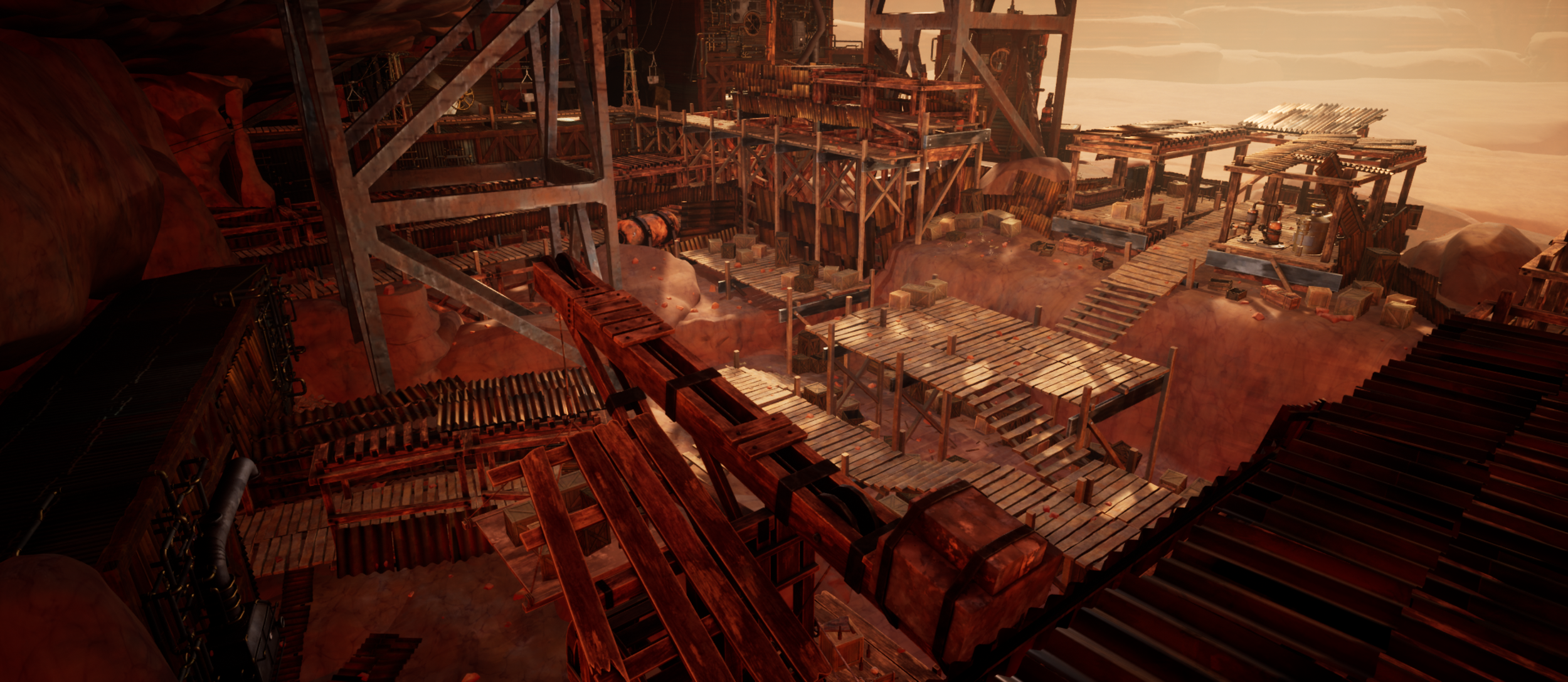BENEATH THE BADLANDS
Overview
Beneath the Badlands is a first-person rogue-lite shooter game focused on a traditional Western style with steampunk aspects.
This game is one of the largest projects at SCAD in the ITGM (Interactive Game Design and Development) with a team consisting of over 40 members. Beneath the Badlands was developed over a small Pre-Production and planning phase, a 10-week Production phase, and a final 10-week Post-Production phase. I was brought onto the team as a Level Designer during its final 10-week Post-Production phase.
Contributions
I was responsible for creating and contributing majorly to 11 out of the game's 25 total levels as well as iterating on the rest. My workflow consisted of Level Ideation, Greyboxing Levels, a First Set Dressing Pass, Encounters/Loot Placement, Additional Set Dressing, and Cleanup for Navmesh after Environment and Lighting artists had done their own passes.
Being a part of this project helped to refine my own workflow by learning new techniques (especially for FPS level design), helped me to get super comfortable with Unreal Engine, learn how to work with a large team, and understand how to work using SCRUM and Waterfall. Communication was invaluable while working on this team, I was constantly in contact with Gameplay Programmers/Designers, Environment Artists, and other Level Designers giving and receiving feedback.
Details
Part of 10-Week Post-Production Phase
Team of 60+
Unreal Engine 5
Perforce
Game Design
Level Design
Gameplay Trailer
Level Ideation and Greyboxing
Ideation
When I joined the team for the Post-Production phase the current levels were all a lot smaller in scale. After talking with my Level Design Lead we both agreed that we had enough smaller levels and needed some larger ones.
As far as ideation goes, I was given a lot of leeway to really experiment and try new ideas. Since most of the current levels were given names that related to its defining feature I decided to follow that trend and design levels based around a type of rock formation or piece of architecture.
The average flow of a level was suppposed to function like this:
Player enters next room in the procedural dungeon, door closes behind them.
In order open the doors to proceed to the next room or leave the way you came from the player needs to destroy a Plague Heart placed somewhere within the center of the level.
Player explores level fighting pre-placed enemies, avoiding hazards, and collecting loot.
Player finds Plague Heart and destroys it, opening doors out of the room.
Player proceeds to the next room in the dungeon.
Level Layout
Cave Concept Art
Ari Zaritsky
Greyboxing
After getting the ok from my lead on whatever idea or sketch I had for a level, I would start blocking it out. While I did do some greyboxing for levels like the shop, we were on a very tight schedule to get a lot of levels finished in not a lot of time.
This lead to “greyboxing” by doing essentially the first pass on set dressing. The rocks that make up our caves were the foundation for all of other setdressing, navmesh, etc. to go on top of. This “rocking-out” of the level is where I spent a majority of time on this project.
After getting a level rocked-out, I also did a first pass on any other major structures, put in a rough lighting pass, and performed an initial pass on any interactables, enemies, and hazards.
As I built the level I would constantly be playtesting it and then going to get feedback from my leads and other designers from their playtests.
Shop Greybox Showcase
Vulture Arena Greybox
Canyon Greybox
Mining Outpost Greybox
Waterfall Greybox
Final Levels
Dungeon Levels
After the setdressing for a level was complete, we would then perform a final pass. This included fixing any set dressing that impeded its functionality, finalizing enemy and hazard placements, and doing a lot of playtesting to make sure the level was ready for the final build.
Canyon
Chasm
Mining Outpost
Pillar
Ravine
Waterfall
Entrances and Exits
Players would enter each floor of the dungeon using a descending elevator. I wanted the player to feel as if they were really entering a new area, so I added a unique entrance and exit for each floor.
Floor 2 Entrance
Floor 3 Entrance
Final Boss Preparation
The Shop
A shop was added to the level roster so that players would be able to take a break from the grueling combat in the caves. Inside were vending and upgrade machines as well as a little bit of loot for the player to collect. I wanted this section to feel separate and safe from the rest of the dungeon, so a longer hallway was added to make sure there was a bit more separation from the other levels. I also wanted to make sure the shop had enough room to where the player felt comfortable and could practice using any new equipment they might have acquired.
The Shop
Boss Fights
Out of the 4 boss fight levels, I majorly contributed to the final two boss fights. Since this was the end of the game I wanted to make sure that these levels felt huge and imposing to keep the stakes feeling high.
























































































































